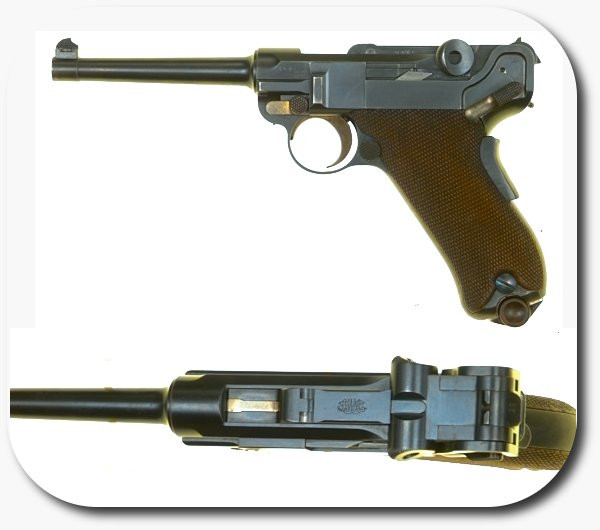HOME | DD
 red-9-jess — LugerMauser'sBro
red-9-jess — LugerMauser'sBro

Published: 2008-02-01 21:29:05 +0000 UTC; Views: 1639; Favourites: 17; Downloads: 61
Redirect to original
Description
The Parabellum-Pistole (Pistol Parabellum), popularly (but incorrectly) known as the Luger is a toggle locked, recoil operated, semi-automatic pistol. The design was patented by Georg Luger in 1898 and produced by German arms manufacturer Deutsche Waffen- und Munitionsfabriken (DWM) starting in 1900; it was an evolution of the 1898 Hugo Borchardt designed C-93.The Luger was made popular by its use by Germany during World War I and World War II. Though the Luger pistol was first introduced in 7.65x22mm Parabellum, it is notable for being the pistol for which the 9x19mm Parabellum cartridge was developed.
HOW IT WORKS: The Luger uses a toggle-lock action, which utilizes a jointed arm to lock, as opposed to the slide actions of almost every other semi-automatic pistol. The mechanism is explained as follows: after a round is fired, the barrel and toggle assembly (both locked together at this point) travel rearward due to recoil. After moving roughly one-half inch (13 mm) rearward, the toggle strikes a cam built into the frame, causing the knee joint to hinge and the toggle and breech assembly to unlock. At this point the barrel stops its rearward movement (it impacts the frame), but the toggle and breech assembly continue moving (bending the knee joint) due to momentum, extracting the spent casing from the chamber and ejecting it. The toggle and breech assembly subsequently travel forward (under spring tension) and the next round from the magazine is loaded into the chamber. The entire sequence occurs in a fraction of a second.
In World War I, as submachine guns were found to be effective in trench warfare, experiments with converting various types of pistols to machine pistols (Reihenfeuerpistolen, literally "rapid-fire pistols") were conducted. Among those the Luger pistol (German Army designation Pistole 08) was examined; however, unlike the Mauser C96, which was converted in great numbers to Reihenfeuerpistole, the Luger proved to have an excessive rate of fire in full-automatic mode.
Wene?: The P.08 was the usual sidearm for German Army personnel in both world wars, though it was being replaced by the Walther P38 starting in 1938. In 1930, Mauser took over manufacture of the P.08 (until 1943).[2] The Swiss Army evaluated the Luger pistol in 7.65 mm P (.30 Luger in USA) and adopted it in 1900 as its standard sidearm, designated Ordonnanzpistole 00 or OP00, in 1900.
'Artillery Luger' Lange Pistole 08 with 32 round Trommelmagazin 08 and removable stock.The Luger pistol was accepted by the German Navy in 1904, and in 1908 (as Pistole 08) by the German Army (chambered in 9x19mm Parabellum) replacing the Reichsrevolver. The Lange Pistole 08 or Artillery Luger had a stock and longer barrel, and sometimes used with a 32 round drum magazine (Trommelmagazin 08).
The United States evaluated several semi-automatic pistols in the late 1800s, including the Colt M1900, Steyr Mannlicher M1894, and an entry from Mauser. In 1900 the US purchased 1000 7.65 mm Lugers for field trials. Later, a small number were sampled in the then-new, more powerful 9 mm round. Field experience with .38 caliber revolvers in the Philippines and ballistic tests would result in a requirement for still-larger rounds.
In 1906, the US Army held trials for a large-caliber semi-automatic. After initial trials, DWM, Savage, and Colt were asked to provide further samples for evaluation. DWM withdrew for reasons that are still debated, though the Army did place an order for 200 more samples
Today: Although obsolete in many ways, the Luger is still sought after by collectors both for its sleek design, superlative accuracy, great durability, and by its connection to Imperial and Nazi Germany. Limited production of the P.08 by its original manufacturer resumed when Mauser refurbished a quantity of them in 1999 for the pistol's centenary. More recently, Krieghoff announced [1] the continuation of its Parabellum Model 08 line with 200 examples at $15,950.00 apiece. The Luger was prized by Allied soldiers during both of the World Wars. Thousands were taken home during both wars, and are still in circulation today.
Look:The Luger pistol was manufactured to exacting standards and has a long service life. Bill Ruger praised the Luger's 55 degree grip angle and duplicated it in his .22 LR pistol.
The Mauser's Little Bro!
























